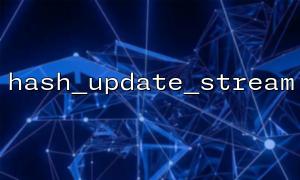hash_update_stream is a function in PHP used to update hash calculations. It allows data to be read from a stream and hash value updated. When processing large amounts of data, using streams can effectively avoid memory overflow problems, while hash_update_stream provides support for different hash algorithms.
In PHP, hash_update_stream is used to add data to the initialized hash context. Its basic syntax is as follows:
bool hash_update_stream ( resource $context , resource $stream [, int $length = 0 ] )
$context is a hash context resource created through hash_init .
$stream is an open stream resource.
$length is optional, indicating the byte length of the read stream. If omitted, all available data in the stream is read by default.
The hash_update_stream function in PHP is used in combination with the hash function and supports multiple hash algorithms. Specifically, hash_update_stream can use the following hash algorithms, which are initialized by the hash_init function:
MD5 ( md5 )
SHA-1 ( sha1 )
SHA-224 ( sha224 )
SHA-256 ( sha256 )
SHA-384 ( sha384 )
SHA-512 ( sha512 )
RIPEMD-160 ( ripemd160 )
Whirlpool ( whirlpool )
Tiger ( tiger )
Snefru ( snefru )
GOST ( gost )
CRC32 ( crc32 )
CRC32B ( crc32b )
Here is a simple example showing how to have hash using hash_update_stream :
<?php
// Open the file stream
$stream = fopen('data.txt', 'rb');
// Initialize hash context,chooseSHA-256algorithm
$context = hash_init('sha256');
// usehash_update_streamUpdate hash value
hash_update_stream($context, $stream);
// Get the final hash value
$hash = hash_final($context);
// Output result
echo "FiledSHA-256The hash value is: " . $hash;
// Close the stream
fclose($stream);
?>
In this example, we chose sha256 as the hashing algorithm. If you need to use other algorithms, just pass the corresponding algorithm name in hash_init .
The hash_update_stream function provides support for a variety of hash algorithms, which makes PHP very flexible when handling large files or streaming data. Choosing the right hashing algorithm can help you find the best balance between performance and security based on specific needs. When using this function, you simply initialize it according to the required algorithm, and then use the stream to gradually update the hash value, and finally get a hash digest of the file or data stream.















